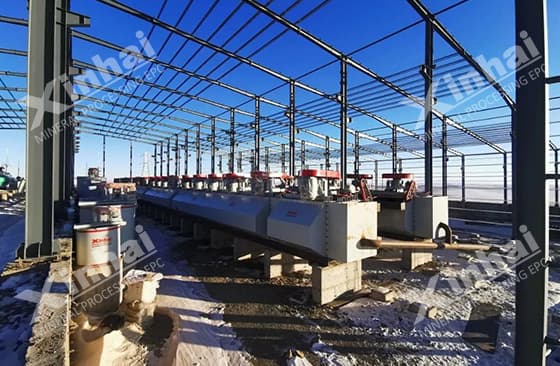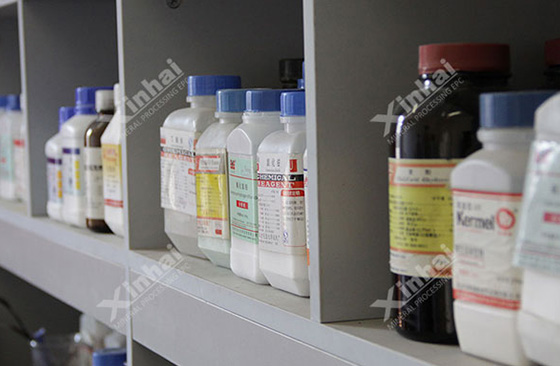
As an important metal resource, copper has been widely used in many fields. The industrial types of copper deposits mainly include porphyry-type copper deposits, skarn-type copper deposits, volcanic rock-type copper deposits, copper-nickel sulfide-type copper deposits, sandstone copper deposits, metamorphic rock layered copper deposits and vein-shaped copper deposits in various wall rocks. Among them, the porphyry copper deposit is the main source of copper resources. In this article, we will introduce the properties of porphyry copper ore and copper ore extraction process.

Porphyry copper deposits refer to copper deposits related to porphyritic intermediate-acid epiphysial or ultra-epasitic intrusive rock masses. The ore structure is mainly disseminated by veinlets. The ore composition of porphyry copper deposits is relatively simple, and the main copper minerals include chalcocite, blue chalcocite, bornite, copper blue and so on. Often associated metal minerals include molybdenum, gold, silver, lead, cobalt, etc. Porphyry copper deposits are also often used as an important source of molybdenum ore, and the recovery of molybdenum ore resources must be considered at the same time when sorting.
In addition to the useful associated minerals, the types of gangue minerals in porphyry copper ore species have a certain impact on the selection of copper ore beneficiation and reagents. In different ore belts, the types of gangue minerals are different, mainly including quartz, potassium feldspar, mica, sericite, kaolinite and so on.

Since there are many kinds of minerals in porphyry copper mines, comprehensive recovery issues often need to be considered. Flotation is often used as the main copper ore extraction process in sorting. In addition, for the flotation process, the selection and dosage of reagents are also very important.
For porphyry copper deposits with relatively high content of molybdenum minerals, copper, molybdenum, and sulfur are generally three types of minerals coexisting. The grade of molybdenum ore in the raw ore is low, and the general process is to first float the copper-molybdenum mixed concentrate, and then separate the copper-molybdenum concentrate to obtain copper concentrate and molybdenum concentrate. It mainly includes two parts: copper beneficiation operation and copper-molybdenum mixed concentrate separation.
Copper beneficiation is mainly based on separation and recovery of copper concentrate. Lime is generally added in the coarse grinding stage to suppress pyrite in the ore. The copper-molybdenum mixed concentrate obtained through flotation generally contains more than 20% copper.
.jpg)
In the separation of copper-molybdenum mixed concentrate, copper inhibition flotation process is generally adopted. The key problem is to desorb the hydrophobic substances of the collector on the surface of copper minerals, change the surface of copper minerals from hydrophobic to hydrophilic, and keep this state during the flotation and separation process of copper and molybdenum. Copper sulfide minerals in porphyry copper ores have good floatability, and a large amount of inhibitors need to be added to reduce their floatability. In order to better separate the copper concentrate from the molybdenum concentrate, the collectors remaining in the pulp can be removed through pretreatment methods such as concentration and dedosage, heating and oxidation.

In the beneficiation stage of porphyry copper ore, the two key flotation agents are collectors and inhibitors. Among them, collectors can be divided into non-ionic collectors, ionic collectors, combined collectors, new collectors, etc. Non-ionic collectors mainly include non-polar hydrocarbon oils and insoluble esters, which can selectively adsorb on the surface of minerals and improve the hydrophobicity of minerals. Combination collectors use two or more collectors in combination to achieve a more effective flotation effect than a single collector. New collectors for porphyry copper deposits include APII, W3, W4, etc. The inhibitors of porphyry copper ore flotation mainly include sodium sulfide, phosphoknox, arsenox, sodium hypochlorite, peroxide, permanganate, dichromate, ferrocyanide and so on.
The above is about the nature and beneficiation of porphyry copper ore. In actual production, the ore properties of different deposits are different, and it is necessary to conduct experimental analysis to formulate a beneficiation process and chemical system that are more suitable for the deposit. Xinhai Mining suggested that the beneficiation test should be carried out first, and a scientific and reasonable beneficiation plan should be formulated according to the test results, which has achieved an ideal return on investment.
To find out more about our products and solutions, please fill out the form below and one of our experts will get back to you shortly.